With the Defy Classic Carbon, Zenith shoots for design boldness, lightweight comfort, and unprecedented price accessibility. We gave the watch a test run and got some insight into its origins from Zenith’s CEO.
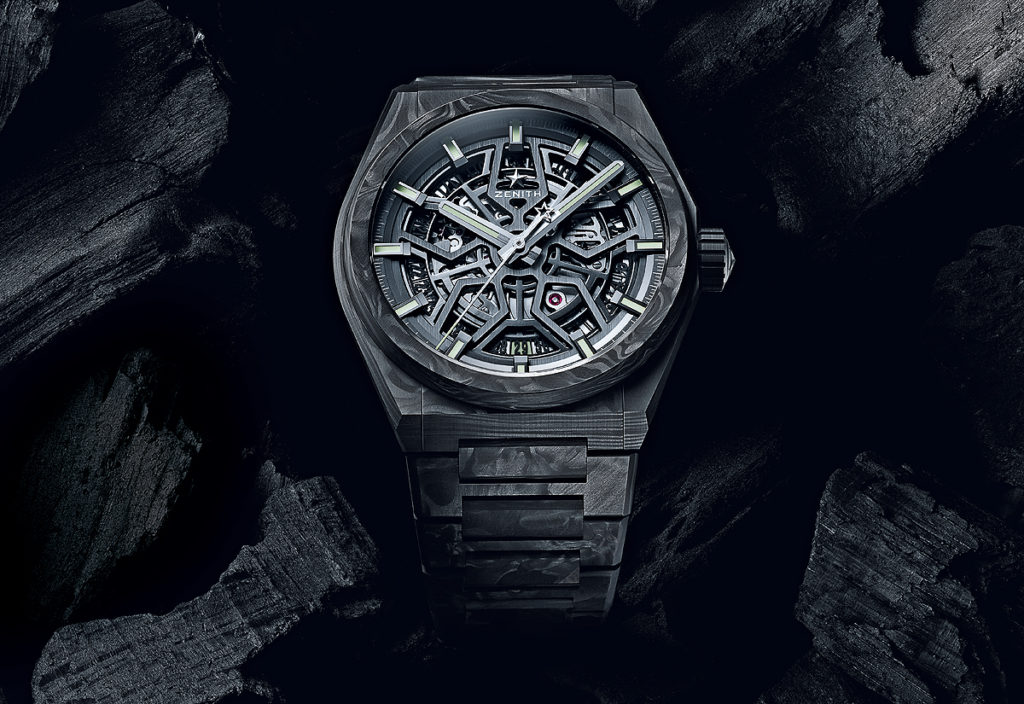
Zenith celebrated its most historically significant anniversary in years in 2019, marking 50 years of El Primero, the automatic, high frequency chronograph movement with which the 155-year-old Swiss watch manufacture has become all but synonymous. Its cavalcade of timepieces inspired by the milestone ranged from a faithful re-creation of the first El Primero watch from 1969 to a decidedly avant-garde piece combining a chronograph with two tourbillon escapements. In 2020, despite the obstacles posed to every industry by the pandemic, Zenith showed little sign of taking its foot off the gas pedal — both in introducing new timepieces and expanding on another of its recent initiatives, namely outfitting more of these watches in high-tech, modern case materials.
The most noteworthy example of this mission is the watch that I review here, the Zenith Defy Classic Carbon, released this fall, which represents not only the first time Zenith has created a “full-carbon” timepiece — i.e., with a case, crown and bracelet all made from forged carbon — but also the first time the watch industry has offered such a piece at a price that is relatively accessible.

“Full carbon” timepieces are quite rare, usually highly complicated, and invariably positioned in a stratospheric price range: Roger Dubuis’s Excalibur Spider Carbon Flying Tourbillon, Richard Mille’s RM 07-01 with carbon TPT case and bracelet, and the Octo Finissimo Minute Repeater Carbon from Zenith’s LVMH stablemate Bulgari are prominent examples. Zenith has also employed a carbon case, but not a carbon bracelet, on a high-complication limited edition, 2019’s Defy Fusee Tourbillon. “Nobody had done a full-carbon watch in this price range,” says Zenith CEO Julien Tornare of the watch, whom we had the chance to speak with during the review period. “If you look at the competition, we’re talking about super-expensive watches, $150,000 and higher. We wanted to make an accessible watch but still an exclusive one, and I think it’s very fairly priced, even though it’s double the cost of the previous Defy Classic.”
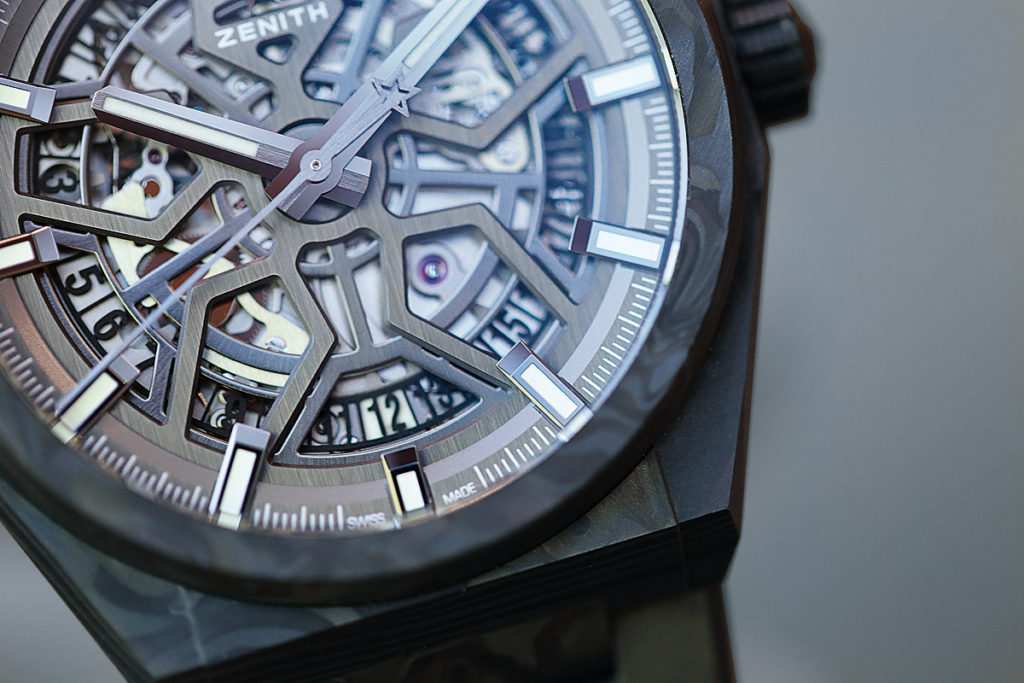
Appropriately, Zenith opted to release its all-carbon pioneer within the revamped Defy collection, which Tornare refers to as “a laboratory where we can have fun and play with different colors and materials.” The company also chose to equip the timepiece not with an El Primero caliber but with its simpler Elite movement, specifically the 670 SK version that has been skeletonized in the eye-catching (and weight-saving) style of previous Defy timepieces. Equipping the watch with a more understated three-hand-date mechanism rather than a complex chronograph allowed Zenith to not only make a more readily legible watch but a more reasonably priced one as well; at $19,500, the Defy Classic Carbon is by far the most cost-effective way to put an all-carbon watch on your wrist.
The familiar barrel-shaped case of the Defy series, 41 mm in diameter, is recognizable here, embellished with the hallmark, textural, striated motif imparted by the carbon material, which catches the light in interesting ways, with matte and shiny areas shifting as the watch moves from side to side. The sides of the case are more subtly enhanced, matte black with thin lines somewhat reminiscent of a subtle wood grain. It’s a look that is very distinct from that of traditional carbon fiber, with its smooth checkerboard pattern — more raw and patchwork, almost “unfinished” in an oddly appealing way, and visually, much more an extension of the skeletonized, gray-tinted dial than a carbon fiber case would have been. Tornare describes the look as “a bit camouflage.”
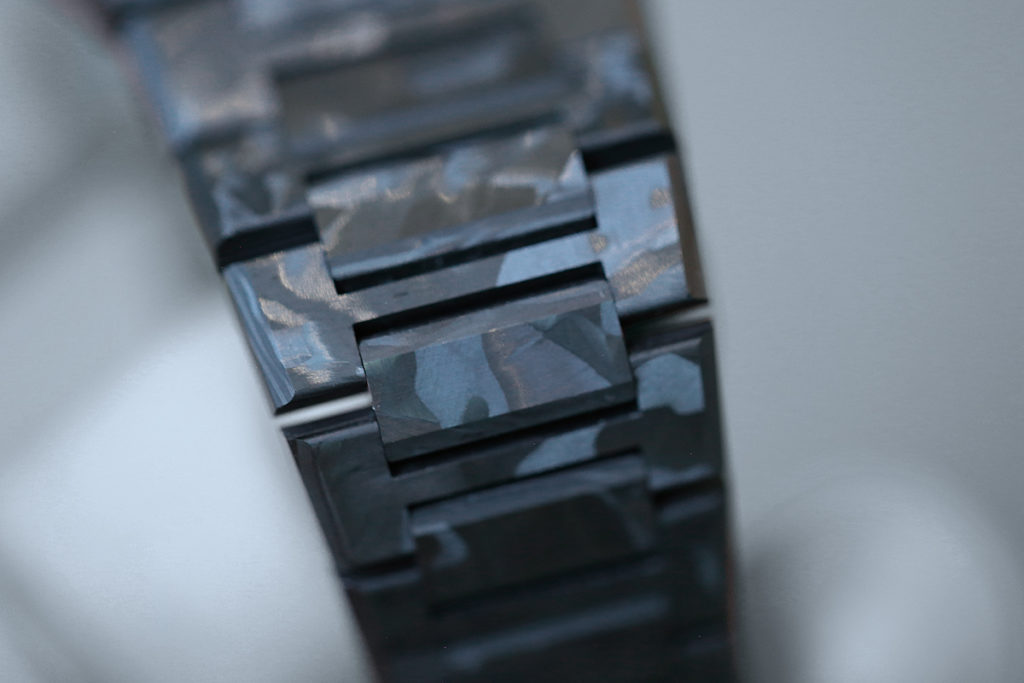
The flat sapphire crystal rises almost imperceptibly above the subtly curved bezel, whose wavy streaked sides echo those of the main casebody. Under it is the three-dimensional skeleton dial, with the five-armed motif that both takes inspiration from the Zenith star logo and brings to mind the wheel rims of a Range Rover Evoque, a nod to Zenith’s recent partnership with the British luxury automaker. On the topmost level are 12 rectangular hour indexes treated with Super-LumiNova, which soaks up ambient light at a very efficient level, along with the luminous-treated hands and the tip of the central running seconds hand. We removed the watch from its case in the morning after several days out of the sunlight and its hands and indexes were glowing bright green by noon, with minimal outdoor sunlight exposure.
All told, the Defy Carbon boasts one of the most easily legible skeleton dials we’ve seen in quite a while, owing both to those very prominent luminous hands and indexes, and also to Zenith’s decision to use the Elite movement, rather than the chronograph-equipped El Primero, whose three subdials and additional hands have, on other models with skeleton designs, added visual panache but hindered legibility. Not all elements are as readable at a glance as the main time display, however: the date display at 6 o’clock, which uses a cutout date wheel with black numerals, with the current date numeral shifting into place in a luminous-treated aperture, is very easy to miss at a glance. If you’re signing checks while wearing the watch, you may want to just check your smartphone’s calendar rather than squint at the dial. Not that a little subtlety on a luxury watch is a bad thing at all.
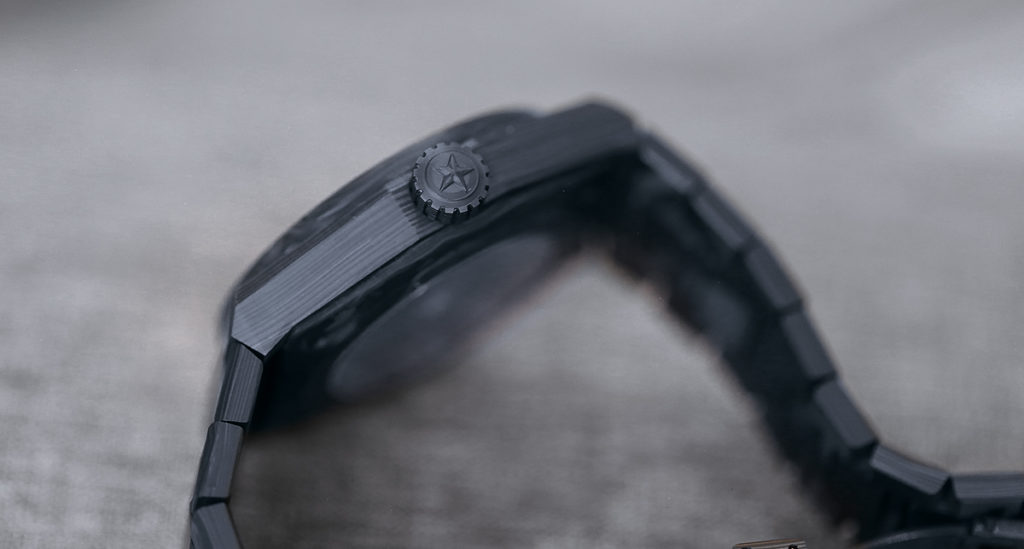
Of course, the overall mission here, with the use of carbon and the skeletonized movement, was not only to make an attractive watch but one that would be lightweight on the wrist. Mounted on the articulated link bracelet, with each individual link made of the carbon material — the only element of the bracelet not made from carbon is the double-folding clasp, which is in PVD-coated titanium — the Defy Classic Carbon is pleasantly light and comfortable. As with most link bracelets, there are some tiny gaps between the links that can pinch, but mostly the bracelet is very tightly constructed and the very slight grit to its smoothly rounded links grows on you very, very quickly. Zenith also offers the carbon case on a black, stitched textile bracelet with a smooth rubber lining — a sportier execution, and one only slightly weightier on the wrist, priced at $11,600.
According to Tornare, the new and somewhat revolutionary bracelet is an example of his product development team going above and beyond the call of duty. “I asked them to work on a case and didn’t expect them to also work on a bracelet,” he explains. “When I tried on [the prototype], it felt so soft, so comfortable, and so different from anything else. It’s made of more than 50 different components in full carbon, so it comes from quite a difficult process. It’s also 40 percent lighter than the version on a titanium bracelet, only around 65 grams. It’s the first time Zenith has produced a bracelet like that. It’s super-high tech and it delivers everything we wanted.”
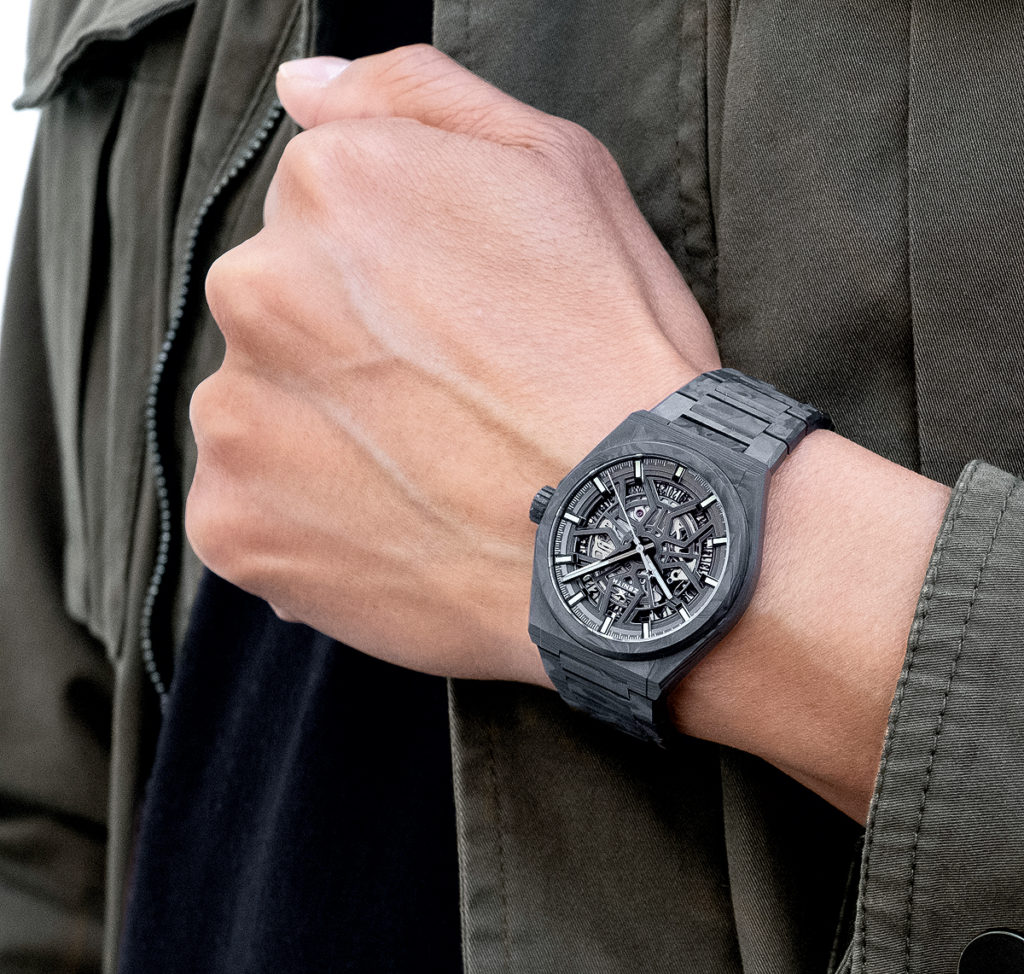
The stealth look of the Defy carbon is reflected in the rear side of its movement as well, with its prominent black-coated rotor, partially skeletonized and shaped like the classical Zenith star emblem, in addition to a host of other finely finished components. Zenith’s Caliber Elite 670 SK (for “SKeletonized”), essentially a simpler, time-and-date-only version of the El Primero, has a frequency of 28,800 vph and a weekend-length power reserve of 50 hours. Silicon — another high-tech material that has found its way into watchmaking relatively recently, and is prized for its antimagnetic properties — is used for the movement’s pallet lever and escape wheel.
Does the Defy Classic Carbon, which will be made in limited quantities but not as a limited edition, herald the use of even more unconventional and even experimental materials by Zenith? Under Tornare’s leadership, the brand has already put a silver case on a Pilot Type 20 watch; a bezel made of aeronith, a high-tech aluminum composite, on the bezel of its Defy Inventor; and even a lapis lazuli dial on a unique, platinum-cased edition of the El Primero A386 made specially for a Phillips charity auction. “We will always do revivals and we will always celebrate the past,” Tornare says, “but it’s also very important to bring new, dynamic facets to the brand. That’s what the people who created El Primero did in the 1960s and that’s what we’ll continue to do.”
SPECS:
Manufacturer: Zenith International SA, Rue de Billodes 34-36, CH-2400 Le Locle, Switzerland
Reference number: 10.9000.670.80.R795
Functions: Hours, minutes, seconds, date
Movement: Zenith Elite Caliber 670 SK, automatic, skeletonized, 27 jewels, 28,800 vph, 50-hour power reserve, silicon pallet lever and escape wheel
Case: Full carbon case, sapphire crystal, sapphire exhibition caseback
Bracelet and clasp: Full carbon link bracelet with blackened titanium folding clasp, also available on a rubber-and- textile strap
Price: $19,500 on bracelet, $11,600 on strap

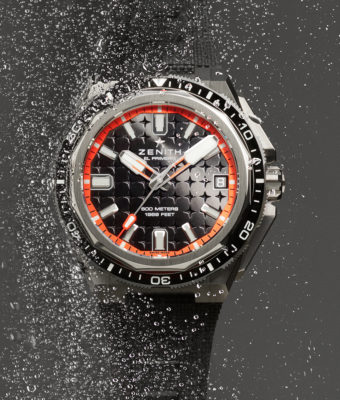
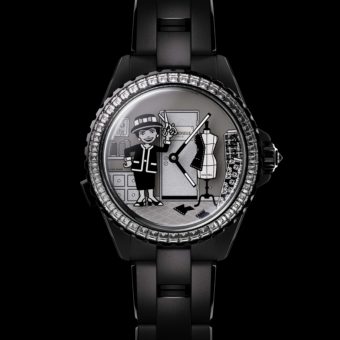
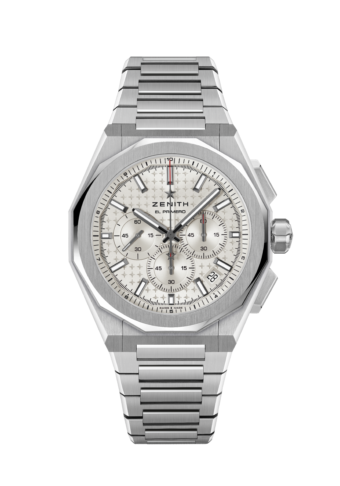
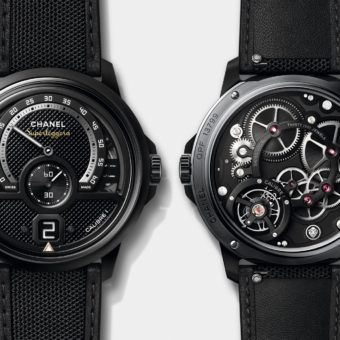
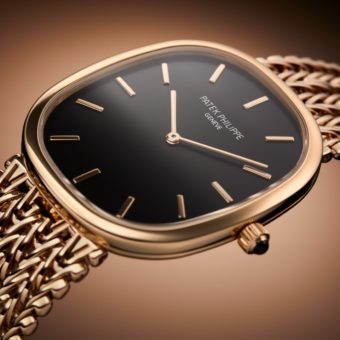
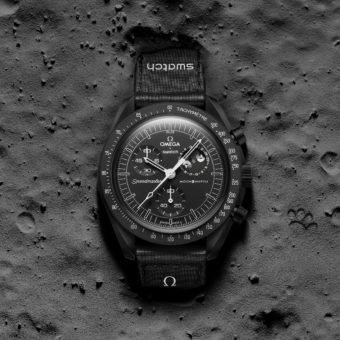
Thank you for a thorough review of a great product. I own the ceramic version of this watch.